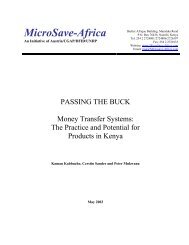Create successful ePaper yourself
Turn your PDF publications into a flip-book with our unique Google optimized e-Paper software.
<strong>DAI</strong> on track to cross the $100 million revenue<br />
threshold, three <strong>years</strong> ahead <strong>of</strong> the strategic<br />
plan target. By the spring <strong>of</strong> 2001, Little had<br />
rebuilt the back <strong>of</strong>fice and the company’s financial<br />
health was restored. But many senior staff<br />
were skeptical <strong>of</strong> her efforts. When one Vice<br />
President complained that <strong>DAI</strong> had become a<br />
financially oriented company, Little laughed and<br />
replied, “Clearly you have never worked in one.”<br />
In 2003, she opted to move on and was succeeded<br />
by Dennis Fransen, another seasoned<br />
CFO who had a background in defense and<br />
technology companies.<br />
The root <strong>of</strong> these problems lay in the fact that<br />
the mind-set <strong>of</strong> a $20 million company—informal,<br />
familiar, and highly personal—didn’t match<br />
the demands <strong>of</strong> a much bigger balance sheet,<br />
projects that could burn through $2 million in a<br />
single month, and a larger, more diverse workforce.<br />
<strong>DAI</strong> had always prided itself on ad hoc<br />
problem-solving, workarounds (for example,<br />
Mickelwait’s decision to let field teams generate<br />
their own invoices and mail copies back to<br />
headquarters), and empowering managers to<br />
use their judgment, even if their homegrown<br />
systems were impossible to replicate. This was<br />
a source <strong>of</strong> friction between those striving to<br />
make the business perform better and those<br />
who felt it was more important to serve beneficiaries<br />
and keep clients happy.<br />
The Board was alarmed that <strong>DAI</strong> could have<br />
slipped so quickly into financial distress. Barclay<br />
was too, and he believed that the Board could<br />
help introduce more financial discipline. For<br />
many <strong>years</strong>, <strong>DAI</strong>’s employee shareholders had<br />
elected a majority <strong>of</strong> the directors, and most<br />
were drawn from the senior management ranks.<br />
Their role had been mainly advisory so long as<br />
the company’s founder served as both CEO<br />
and Chairman. As stewards <strong>of</strong> the informal<br />
culture that had molded <strong>DAI</strong>, they tended to be<br />
conservative in their outlook when it came to<br />
making new rules and enforcing standardized<br />
procedures.<br />
The Board itself was changing, however—<br />
evidenced by its role in steering the succession<br />
process—and its fiduciary responsibility<br />
to ensure the firm’s financial health was now<br />
paramount. With Barclay’s encouragement,<br />
and leadership from Dave Gunning and Marcia<br />
Sharp, the Board’s governance committee<br />
began to realign its membership so that most<br />
directors were independent. A new policy took<br />
effect requiring that all employee directors<br />
except the CEO should come from the ranks<br />
below the executive team level. This produced<br />
clearer differentiation between the Board and<br />
management, and showed that <strong>DAI</strong> was coming<br />
to grips with the requirements <strong>of</strong> a larger<br />
company with obligations to external stakeholders<br />
(bankers and clients) as well as internal ones<br />
(employee shareholders).<br />
71



